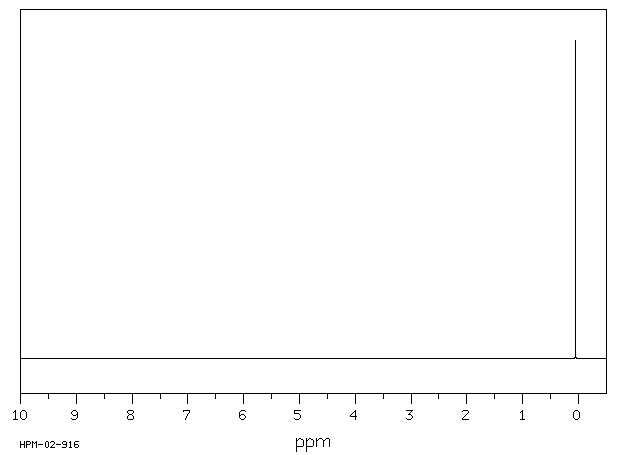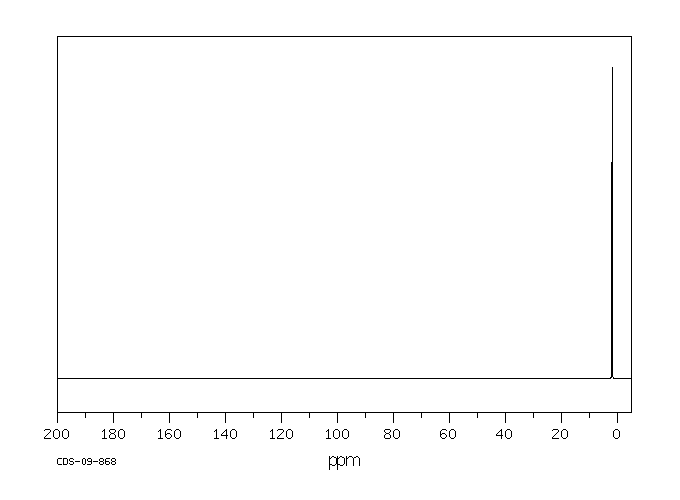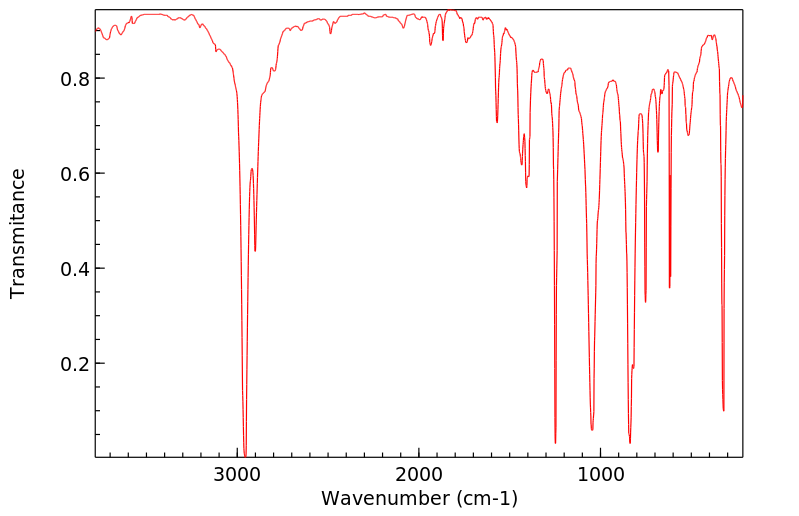六甲基二硅氧烷 | 107-46-0
-
物化性质
-
计算性质
-
ADMET
-
安全信息
-
SDS
-
制备方法与用途
-
上下游信息
-
文献信息
-
表征谱图
-
同类化合物
-
相关功能分类
-
相关结构分类
物化性质
-
熔点:−59 °C(lit.)
-
沸点:101 °C(lit.)
-
密度:0.764 g/mL at 20 °C(lit.)
-
蒸气密度:>1 (vs air)
-
闪点:33 °F
-
溶解度:0.00037g/l
-
介电常数:2.2(20℃)
-
LogP:5.06 at 20℃
-
物理描述:DryPowder; Liquid
-
颜色/状态:FLUID
-
蒸汽压力:42 mm Hg at 25 °C (est)
-
大气OH速率常数:1.38e-12 cm3/molecule*sec
-
分解:When heated to decomposition it emits acrid smoke, fumes.
-
粘度:0.51 centistokes at 20 °C
-
折光率:Index of Refraction: 1.3774 at 20 °C
-
保留指数:597.4;597.4;598;645;646
-
稳定性/保质期:
计算性质
-
辛醇/水分配系数(LogP):3.03
-
重原子数:9
-
可旋转键数:2
-
环数:0.0
-
sp3杂化的碳原子比例:1.0
-
拓扑面积:9.2
-
氢给体数:0
-
氢受体数:1
ADMET
安全信息
-
TSCA:Yes
-
危险等级:3
-
危险品标志:F
-
安全说明:S16
-
危险类别码:R11
-
WGK Germany:3
-
海关编码:29310095
-
危险品运输编号:UN 1993 3/PG 2
-
危险类别:3
-
RTECS号:JM9237000
-
包装等级:II
-
危险标志:GHS02,GHS09
-
危险性描述:H225,H410
-
危险性防范说明:P210,P273,P391,P403 + P235,P501
-
储存条件:储存注意事项: - 储存在阴凉、干燥且通风良好的非可燃库房中。 - 远离火源和热源,库温不宜超过37℃。 - 包装需密封,避免与空气接触。 - 应与氧化剂、酸类、碱类等分开存放,禁止混储。 - 使用防爆型照明和通风设施。 - 禁止使用易产生火花的机械设备和工具。 - 储存区应配备泄漏应急处理设备及合适的收容材料。
制备方法与用途
六甲基二硅氧烷(简称MM封头剂),是一种无色透明液体,易潮解。不溶于水,但能溶解在多种有机溶剂中。其用途广泛,可作为硅油、硅橡胶、药品、气相色谱固定液、分析试剂、憎水剂等的原料。
物理性质六甲基二硅氧烷是一种无色透明液体,具有易潮解和易燃特性,在高温或明火下容易引发燃烧。其沸点为99.5℃,闪点-1.1℃,相对密度0.7606,折射率1.3750。不溶于水,但能溶解在多种有机溶剂中。
应用六甲基二硅氧烷是一种重要的有机硅初级原料。作为封端剂用于生产有机硅硅油;也可用于制造硅橡胶、药品、气相色谱固定液、分析试剂、憎水剂及医疗电子元件等,还可用作清洗剂和脱膜剂。
制备六甲基二硅氧烷的制备通常由三甲基氯硅烷、水和氢氧化钠在500ml三口烧瓶中反应合成。最优化工艺条件为:加入0.4mol的氢氧化钠固体,反应温度25℃,反应时间30min,水∶三甲基氯硅烷体积比1:1。此条件下可得到最高99.95%的收率和99.876%的纯度。
化学性质六甲基二硅氧烷是一种无色透明液体,不溶于水但能溶解在多种有机溶剂中。
用途该产品可用于封头剂、清洗剂、脱膜剂等。广泛应用于有机化工及医药生产领域;也可用作憎水剂和绝缘材料的防潮剂;用于制造各类有机硅产品,还可用于纤维织物表面处理和无线电零件的绝缘防潮,以及气相色谱固定液。
生产方法工业上通常采用将三甲基氯硅烷在30-40℃下水解的方法来制备六甲基二硅氧烷。例如,可先将62.49g(0.575mol)三甲基氯硅烷滴加至72.7g(0.06mol)N,N-二甲基苯胺和7g水的溶液中加热回流1h。再常压蒸馏,收集98-101℃馏分即得六甲基二硅醚。
安全信息 分类易燃液体
毒性分级中毒
急性毒性口服 - 大鼠LDL0:8毫升/公斤;腹腔 - 小鼠 LD50: 4500毫克/公斤
刺激数据皮肤 - 兔子 500毫克/24小时 轻度
可燃性危险特性遇明火、高温或氧化剂易燃,燃烧时产生刺激烟雾
储运特性库房需通风低温干燥,并与氧化剂和酸类分开存放
灭火方法干粉、干砂、二氧化碳、泡沫
上下游信息
-
上游原料
中文名称 英文名称 CAS号 化学式 分子量 五甲基二硅氧烷 1,1,1,3,3-pentamethyl-1,3-disiloxane 1438-82-0 C5H16OSi2 148.352 —— pentamethyldisiloxanol 56428-93-4 C5H16O2Si2 164.352 -
下游产品
中文名称 英文名称 CAS号 化学式 分子量 五甲基二硅氧烷 1,1,1,3,3-pentamethyl-1,3-disiloxane 1438-82-0 C5H16OSi2 148.352 —— 1,3,3,3-tetramethyl-1-ethyldisiloxane 7489-77-2 C6H18OSi2 162.379 —— pentamethyldisiloxanol 56428-93-4 C5H16O2Si2 164.352 乙烯基五甲基二硅烷 1,1,3,3,3-pentamethyl-1-vinyldisiloxane 1438-79-5 C7H18OSi2 174.39 —— [Dimethyl(trimethylsilyloxy)silyl]methanol 4846-43-9 C6H18O2Si2 178.379
反应信息
-
作为反应物:参考文献:名称:Cowley et al., Journal of the Chemical Society, 1959, p. 717摘要:DOI:
-
作为产物:描述:alkaline earth salt of/the/ methylsulfuric acid 反应 10.0h, 生成 六甲基二硅氧烷参考文献:名称:Stepovik; Kazakina; Martynova, Russian Journal of General Chemistry, 2000, vol. 70, # 9, p. 1371 - 1377摘要:DOI:
-
作为试剂:描述:N'-(4,6-diphenoxy-1,3,5-triazin-2-yl)formohydrazide 在 六甲基二硅氧烷 、 四磷十氧化物 作用下, 以 5,5-dimethyl-1,3-cyclohexadiene 为溶剂, 生成 5,7-diphenoxy-[1,2,4]triazolo[1,5-a][1,3,5]triazine参考文献:名称:10.1016/j.bioorg.2024.107659摘要:DOI:10.1016/j.bioorg.2024.107659
文献信息
-
Phosphorus–fluorine chemistry. Part XXI. Pentafluorophenylfluorophosphines and pentafluorophenylfluorophosphoranes作者:M. Fild、R. SchmutzlerDOI:10.1039/j19690000840日期:——The preparation of the fluorophosphines, (C6F5)nPF3–n, and of the fluorophosphoranes, (C6F5)nPF5–n, as well as of the related oxygen species, (C6F5)nP(:O)F3–n(n= 1, 2) is described. 19F and 31P N.m.r. data for the new compounds are reported and discussed.
-
Metal–Organic Framework with Dual Active Sites in Engineered Mesopores for Bioinspired Synergistic Catalysis作者:Yangjian Quan、Yang Song、Wenjie Shi、Ziwan Xu、Justin S. Chen、Xiaomin Jiang、Cheng Wang、Wenbin LinDOI:10.1021/jacs.0c02966日期:2020.5.13strong Lewis acid and photoredox sites in engineered mesopores. Al-MOF (1) with mixed 2,2'-bipyridyl-5,5-dicarboxylate (dcbpy) and 1,4-benzenediacrylate ligands was oxidized with ozone and then tiflated to generate strongly Lewis acidic Al-OTf sites in the mesopores, followed by the installation of [Ir(ppy)2(dcbpy)]+ (ppy = 2-phenylpyridine) sites to afford 1-OTf-Ir with both Lewis acid and photoredox在这里,我们通过在工程介孔中安装强路易斯酸和光氧化还原位点来报告模拟酶的金属有机框架 (MOF) 1-OTf-Ir 的设计。具有混合 2,2'-联吡啶-5,5-二羧酸酯 (dcbpy) 和 1,4-苯二丙烯酸酯配体的 Al-MOF (1) 用臭氧氧化,然后 tiflated 以在介孔中生成强路易斯酸性 Al-OTf 位点,然后安装 [Ir(ppy)2(dcbpy)]+ (ppy = 2-苯基吡啶) 位点以提供具有路易斯酸和光氧化还原位点的 1-OTf-Ir。1-OTf-Ir 有效地催化 N-羟基邻苯二甲酰亚胺酯或芳基溴甲基酮与乙烯基或炔基氮杂芳烃的还原交叉偶联,以提供新的氮杂芳烃衍生物。1-OTf-Ir 能够催化合成抗胆碱能药物苯那敏和氯苯那敏。
-
<i>N</i>-Methylacridinium Salts: Carbon Lewis Acids in Frustrated Lewis Pairs for σ-Bond Activation and Catalytic Reductions作者:Ewan R. Clark、Michael J. InglesonDOI:10.1002/anie.201406122日期:2014.10.13N‐methylacridinium salts are Lewis acids with high hydride ion affinity but low oxophilicity. The cation forms a Lewis adduct with 4‐(N,N‐dimethylamino)pyridine but a frustrated Lewis pair (FLP) with the weaker base 2,6‐lutidine which activates H2, even in the presence of H2O. Anion effects dominate reactivity, with both solubility and rate of H2 cleavage showing marked anion dependency. With the optimal
-
<i>N</i>-(<i>tert</i>-Butyldimethylsilyl)imidazole and related heterocycles: <sup>13</sup>C nuclear magnetic resonance study and reaction with dimethylsulfoxide作者:Alexander F. Janzen、Gerald N. Lypka、Roderick E. WasylishenDOI:10.1139/v80-010日期:1980.1.1
N-tert-Butyldimethylsilyl derivatives of imidazole, 2-methylimidazole, 4-methylimidazole, benzimidazole, pyrazole, 1,2,4-triazole, and benzotriazole were prepared from tert-butyldimethylsilyl chloride and the corresponding heterocyclic compound. The products were identified by carbon and proton nmr, mass spectrometry, and elemental analysis. The carbon nmr spectra confirmed the absence of intermolecular silyl exchange at ambient temperature. Silyl exchange did occur at elevated temperatures, 130–160 °C.Reaction of N-tert-butyldimethylsilyl or N-trimethylsilyl heterocycles with dimethylsulfoxide gave N-(methylthio)methyl derivatives of imidazole, 2-methylimidazole, 4-methylimidazole, benzimidazole, pyrazole, and 1,2,4-triazole. The products were characterized by carbon and proton nmr, mass spectrometry, and elemental analysis. A mechanism involving a Pummerer rearrangement is proposed to account for the results.
-
Lewis Base Catalyzed Selective Chlorination of Monosilanes作者:Alexander G. Sturm、Julia I. Schweizer、Lioba Meyer、Tobias Santowski、Norbert Auner、Max C. HolthausenDOI:10.1002/chem.201803921日期:2018.12.3A preparatively facile, highly selective synthesis of bifunctional monosilanes R2SiHCl, RSiHCl2 and RSiH2Cl is reported. By chlorination of R2SiH2 and RSiH3 with concentrated HCl/ether solutions, the stepwise introduction of Si−Cl bonds is readily controlled by temperature and reaction time for a broad range of substrates. In a combined experimental and computational study, we establish a new mode
表征谱图
-
氢谱1HNMR
-
质谱MS
-
碳谱13CNMR
-
红外IR
-
拉曼Raman
-
峰位数据
-
峰位匹配
-
表征信息










